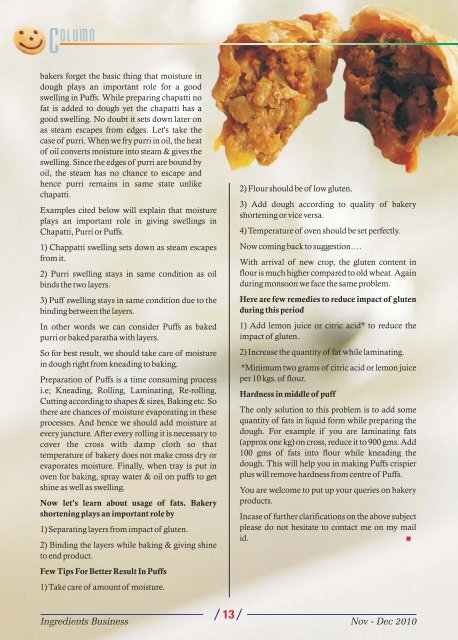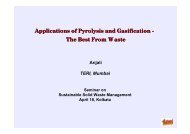BUSINESS - new media
BUSINESS - new media
BUSINESS - new media
You also want an ePaper? Increase the reach of your titles
YUMPU automatically turns print PDFs into web optimized ePapers that Google loves.
C OLUMN<br />
bakers forget the basic thing that moisture in<br />
dough plays an important role for a good<br />
swelling in Puffs. While preparing chapatti no<br />
fat is added to dough yet the chapatti has a<br />
good swelling. No doubt it sets down later on<br />
as steam escapes from edges. Let's take the<br />
case of purri. When we fry purri in oil, the heat<br />
of oil converts moisture into steam & gives the<br />
swelling. Since the edges of purri are bound by<br />
oil, the steam has no chance to escape and<br />
hence purri remains in same state unlike<br />
chapatti.<br />
Examples cited below will explain that moisture<br />
plays an important role in giving swellings in<br />
Chapatti, Purri or Puffs.<br />
1) Chappatti swelling sets down as steam escapes<br />
from it.<br />
2) Purri swelling stays in same condition as oil<br />
binds the two layers.<br />
3) Puff swelling stays in same condition due to the<br />
binding between the layers.<br />
In other words we can consider Puffs as baked<br />
purri or baked paratha with layers.<br />
So for best result, we should take care of moisture<br />
in dough right from kneading to baking.<br />
Preparation of Puffs is a time consuming process<br />
i.e; Kneading, Rolling, Laminating, Re-rolling,<br />
Cutting according to shapes & sizes, Baking etc. So<br />
there are chances of moisture evaporating in these<br />
processes. And hence we should add moisture at<br />
every juncture. After every rolling it is necessary to<br />
cover the cross with damp cloth so that<br />
temperature of bakery does not make cross dry or<br />
evaporates moisture. Finally, when tray is put in<br />
oven for baking, spray water & oil on puffs to get<br />
shine as well as swelling.<br />
Now let's learn about usage of fats. Bakery<br />
shortening plays an important role by<br />
1) Separating layers from impact of gluten.<br />
2) Binding the layers while baking & giving shine<br />
to end product.<br />
Few Tips For Better Result In Puffs<br />
1) Take care of amount of moisture.<br />
2) Flour should be of low gluten.<br />
3) Add dough according to quality of bakery<br />
shortening or vice versa.<br />
4) Temperature of oven should be set perfectly.<br />
Now coming back to suggestion….<br />
With arrival of <strong>new</strong> crop, the gluten content in<br />
flour is much higher compared to old wheat. Again<br />
during monsoon we face the same problem.<br />
Here are few remedies to reduce impact of gluten<br />
during this period<br />
1) Add lemon juice or citric acid* to reduce the<br />
impact of gluten.<br />
2) Increase the quantity of fat while laminating.<br />
*Minimum two grams of citric acid or lemon juice<br />
per 10 kgs. of flour.<br />
Hardness in middle of puff<br />
The only solution to this problem is to add some<br />
quantity of fats in liquid form while preparing the<br />
dough. For example if you are laminating fats<br />
(approx one kg) on cross, reduce it to 900 gms. Add<br />
100 gms of fats into flour while kneading the<br />
dough. This will help you in making Puffs crispier<br />
plus will remove hardness from centre of Puffs.<br />
You are welcome to put up your queries on bakery<br />
products.<br />
Incase of further clarifications on the above subject<br />
please do not hesitate to contact me on my mail<br />
id.<br />
<br />
13<br />
Ingredients Business Nov - Dec 2010

















